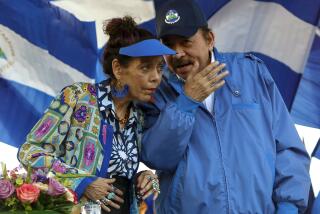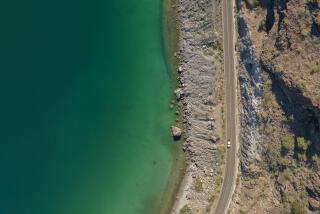Boat Travel Tradition Revitalized in Nicaragua
- Share via
RAMA, Nicaragua — Living in a sliver of a country hemmed in by two oceans, in a land where the rivers are as wide as lakes and the lakes are so big the Spanish conquerors called them freshwater seas, most Nicaraguans consider themselves sailors by heritage.
Boats are part of their national character--and the main form of transportation for the more than 500,000 of their countrymen who live on islands or along riverbanks without roads.
“We have ocean on the outside and, inside, rivers and lakes,” said Ariel Montoya, the editor of the literary magazine Decenio. “That has made us adventurers.”
It’s a tradition that had been in danger of vanishing as remote communities pressured the government for roads. But after watching the destruction that occurs when a highway is cut through the wilderness, giving access to loggers and their buzz saws, authorities here are promoting boat travel and transportation as the best hope for preserving the country’s forests and jungles.
As a result, Nicaragua’s 842 miles of navigable waterways--most in the country’s east, which has a single, partially paved highway--are receiving new recognition as an alternative to roadways.
It’s a revival of sorts. Until the Panama Canal opened in 1914, Nicaragua was the closest thing available to the maritime passageway to the Far East that Christopher Columbus had sought, although he never realized it.
The explorer left Nicaragua disappointed nearly 500 years ago after running aground at El Bluff near the mouth of the Escondido River, which runs through--and brings life to--this remote community. He then sailed right past the San Juan River farther south, which became the 19th century shortcut between the Atlantic and Pacific oceans.
During the California gold rush, Cornelius Vanderbilt’s boats took ‘49ers who came by ship from New York up the San Juan River to Lake Nicaragua. After they crossed the lake on the steamer Victoria, only 12 miles of land divided them from the Pacific Ocean and another Vanderbilt steamer to California. That cut thousands of miles off a journey ‘round the Horn.
“The eyes of the world were on Nicaragua then,” said writer Gioconda Belli, whose best-known novels are set on Nicaraguan waterfronts. “This has affected my country’s entire history.”
Beyond the historical significance of the waterways, boats are undeniably the cheapest form of transportation in remote areas without roads. A plane ticket from Bluefields, at the mouth of the Escondido River, to Corn Island in the Caribbean costs $22. The boat fare is $3. In addition, not even commuter lines fly into communities like Rama, and the tiny planes have no space for cargo.
So most Nicaraguans take the boat, hanging hammocks from the rafters or staking out a temporary territory on a bench.
Recently, a boat with the unfortunate name of Titanic made its way down the San Juan River, which separates Nicaragua from Costa Rica. A canoe approached rapidly from the shore, and, fearing a collision, passengers gestured wildly to the paddler.
At the last minute, 63-year-old Maria Hernandez neatly pulled her canoe alongside the Titanic. She threw ropes that the relieved passengers tied to the boat to hold her canoe steady, and then she sold packets wrapped in banana leaves.
The tropical box lunches of chicken, rice and plantains sold within minutes. Then Hernandez swung herself onto the boat, carrying a bucket of tamales, which she emptied on one walk around the deck. In less time than a coffee break, she was back in her canoe, paddling for shore.
Lucky travelers catch a boat like the Titanic that is designed to carry passengers. But those in too much of a hurry to wait for the sporadic passenger boats must ride on a freighter, like El Isleno, which leaves Rama every Sunday for Corn Island with a stop at El Bluff.
These passengers must find a place to stand or squat for 12 hours or longer among the charcoal, bottled water, natural gas canisters and vegetables on their way to Nicaragua’s only Caribbean island.
“The hardest part is navigating at night,” said Capt. Mateo Vidaure, 28, who has been a sailor for five years. “Then, when there is bad weather and the sea is rough, it is difficult.”
Vidaure, whose two brothers are also sailors, has no romantic illusions about the rivers and seas he sails. “Even if I didn’t like it, what could I do?” he said. “It’s all I know how to do.”
Nicaragua’s boatmen are an independent lot, most of them owning only one or two of the country’s 112 registered commercial boats and pangas, which are like canoes with outboard motors.
“There are only three real companies, and none of them has more than five boats each,” said Miguel Malespin, Nicaragua’s director of ports and navigational development. “None is big enough to dominate the market.”
Then there are the unregistered boats.
Gliding along the Escondido River, with the drone of the diesel motor and jungle on both shores, a middle-age man who identified himself only as Mario talked about his days as a drug smuggler. He dodged authorities through the lagoons of eastern Nicaragua with his cargoes of cocaine, he said.
In Nicaragua, water has always been the escape route for clever locals. Navigating those wide expanses of lakes and rivers is not as easy as it looks. Much of the water is quite shallow, and a boatman who doesn’t know where the channels are will come aground quickly, as Columbus learned.
Beyond their mundane function as highways for commerce and travel, Nicaragua’s lakes and rivers are its playgrounds. The national favorite is Lake Cocibolca, better known as Lake Nicaragua, an expanse of water 16 times the size of Lake Tahoe. On Sunday afternoons, adults sip rum and savor fish at lakeside restaurants while children splash in the shallow water near the shore.
A Nicaraguan’s idea of privacy is a cottage on one of the lake’s isletas, an archipelago of hundreds of islands, most no bigger than a backyard, some merely a few minutes’ boat ride from Granada. Cellular telephone signals are sporadic in this Central American Venice, and the only electricity comes from generators.
Interspersed among the vacation homes of the wealthy and the aspiring are tiny islands with fishermen’s shanties. Ferrying visitors out to the islands is an extra source of income for the fishermen.
On the way, they usually steer past the shipwrecked yacht of the late dictator Anastasio Somoza Debayle, which lies rusting on one island beach.
Because Lake Nicaragua is still relatively unpolluted--compared with the smaller Lake Managua, north of the capital--fish from here are prized. Last year, residents worried when flooding caused by tropical storm Mitch reopened a long-dry river that connects the two lakes, threatening to pollute Lake Nicaragua.
Cleaning up Lake Managua is part of the government’s longer-range plans to revive Nicaraguan boating.
The government is in the process of privatizing the lake’s boats in the hope of improving transportation, Malespin said. Right now, crossing the lake requires a choice that is more like a dilemma: an ancient hydrofoil, which may arrive in less than four hours but is just as likely to break down, or a 12-hour ordeal on a ferry where the smells from the stopped-up bathrooms mix with the scent of overused cooking oil.
They are the only means of transportation for the 38,000 inhabitants of Ometepe, a volcanic island with no flat area for a landing strip. To provide an alternative to residents of San Carlos, previous governments built a road around the water.
Nicaraguans have been appalled by the consequences. “When you open a highway, you open the agricultural frontier,” Malespin said.
Illegal logging has denuded the forests along the highway. Farmers have followed, planting on land that was once rain forest. Constructing the only road in eastern Nicaragua, stretching from Managua to Puerto Cabezas in the north, produced similar results.
After seeing those examples, the Nicaraguan authorities have decided not to build a road along this country’s southeastern border, which is mainly nature reserves. A project for a highway to Bluefields is also being hotly debated and appears likely to be scrapped.
“Water transport,” Malespin said, “is always going to have an important role.”
More to Read
Sign up for The Wild
We’ll help you find the best places to hike, bike and run, as well as the perfect silent spots for meditation and yoga.
You may occasionally receive promotional content from the Los Angeles Times.





